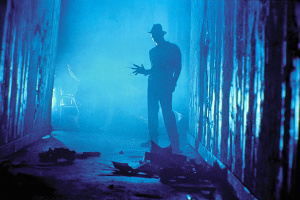
Director: Wes Craven
Writer: Wes Craven
Starring: John Saxon, Ronee Blakley, Heather Langenkamp, Amanda Wyss
After a few successful years of constant hits, the slasher film was starting to lose its appeal when fledging company New Line released their stalk and slash fantasy A Nightmare on Elm Street in the November of 1984. Written and directed by former university professor Wes Craven, who had enjoyed a decade of hit and miss genre efforts (such as The Last House on the Left, The Hills Have Eyes, Swamp Thing), his latest chiller would prove to be his breakthrough movie and his most popular creation, dream stalker Freddy Krueger, would become a major staple of modern pop culture. It would make a genre star out of actor Robert Englund and would launch Craven into the A-list, later moving onto such blockbusters as Scream.
The first draft of what would later become A Nightmare on Elm Street was written in 1981, but the seed of the concept was planted much earlier. Craven had once read a piece in the LA Times regarding a group of Cambodian teenagers, seemingly unrelated to one another, who had expressed concern over the horrifying nightmares they had been having, only to later die in their sleep. This stirred an interest in Craven, who had been lecturing English and Humanities in college and university, and prompted him to research into the nature of dreams. The illogical and broken narrative of nightmares would become a major theme of his screenplay, though Craven knew that he would need some kind of iconic antagonist to orchestrate all the mayhem.
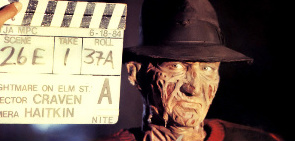
When he was a child, Craven had been terrified by a vagrant that was standing outside his house one night, staring up at his bedroom window. Every time the boy returned to look outside the strange man was still there, seemingly enjoying torturing the kid. During this time, Craven was being teased and bullied by a classmate by the name of Fred Krueger, whose moniker would not only inspire the name of Elm Street‘s villain but also the chief rapist of Craven’s 1972 debut The Last House on the Left. Another possible influence was the crimes of Peter Woodcock, a notorious serial killer in Canada in the 1950’s, who would rape and murder children, before finally being apprehended in 1957 (the same year as Ed Gein, the ultimate slasher). In 1982, a quarter of a century after his arrest, Woodcock legally changed his name to David Michael Krueger.
Once satisfied with his screenplay, Craven began shopping it around various studios, though most passed on the idea, until Disney expressed interest in adapting the project as a family movie. Eventually, Robert Shaye, the CEO of New Line, opted to meet Craven and discuss the story. New Line had been a distributor of foreign films until, in 1982, Shaye produced the company’s first original feature, Alone in the Dark (directed by Jack Sholder, who would eventually helm A Nightmare on Elm Street 2: Freddy’s Revenge), yet with Elm Street he decided to invest all his money into the project. If it was a success he could become a major player, but if it failed then he would have to declare bankruptcy.
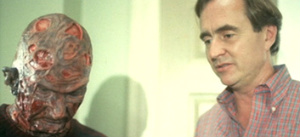
Perhaps Craven’s most ingenious decision was with his casting, most notably that of Fred Krueger, the child murderer that was stalking the teenagers of Springwood, Ohio. The role eventually went to Robert Englund, a scrawny thirty-six year old actor who had appeared as a friendly alien in the hit show V, as well as the cult thriller Dead and Buried, but he had yet to become a recognisable face. His performance as Fred was a large part of the success of the movie, as he made the character genuinely creepy and menacing, something that the later sequels would forget. Top-billed in the credits was genre veteran John Saxon, who had previously been seen in Mario Bava’s The Girl Who Knew Too Much, Canadian Black Christmas and the controversial splatter flick Cannibal Apocalypse. In the central role of Nancy, who would become Freddy’s nemesis, was nineteen year old Heather Langenkamp, whose only decent role to date, in Francis Ford Coppola’s The Outsiders, had been deleted prior to release.
One actor to make his debut with A Nightmare on Elm Street was Johnny Depp, a wannabe guitarist who had attended the audition to offer support to his friend Jackie Earle Haley (who had appeared in Bad New Bears, directed by Friday the 13th’s Sean S. Cunningham). He lost out on the role but the producers took a liking to Depp and offered him his first part, despite it being clear that he was unable to act. Yet he would be remembered for one major thing – his death. His character, Glen Lantz, falls asleep and is sucked into the bed, his blood spraying out like a geyser. This effect was created by the set being revolved upside down (which had been used for the first murder scene) and then blood poured out through the hole, which would flood across the ceiling.
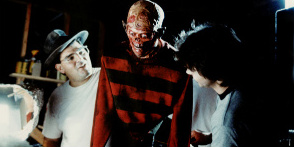
Craven’s major obstacle during filming was the final scene, where his ideas would conflict with Shaye’s, who had gone out on a limb to keep the production running. Once Nancy had defeated Freddy she wakes up the following morning to find her friends alive once again, but as she rides off to school her mother is sucked back through the front door. Despite Shaye claiming that this was not out of a desire for a sequel, it is painfully clear that his motivation was to keep an open-ending in case the movie made enough money that another would be a possibility. Craven hated the ending, yet he was grateful that his movie had finally been completed. Shaye then tried to sell the product to potential distributors, eventually approaching Paramount, who had enjoyed major success with Friday the 13th. Frank Mancuso Jr., who had recently become the studio’s CEO, refused to buy the movie, as he claimed that horror audiences would not be interested in a film about dreams. Finally, Shaye decided to distribute it himself.
A Nightmare on Elm Street was released on a hundred and sixty five screens on November 19th, 1984, and within its first week had made back its $1.8m budget. It would eventually go on to make $25.5m at the US box office, helping to establish New Line as a profitable and respected Hollywood studio. It would later be dubbed ‘The House that Freddy Built,’ due to Elm Street‘s part in its success. As the decade progressed, one sequel after another would dampen Freddy’s effect and reduce him to a pantomime villain, eventually splicing him with Jason Voorhees, Friday the 13th‘s antagonist, for the crossover hit Freddy vs. Jason. Now, with the recent revival of Jason, New Line and Michael Bay’s Platinum Dunes have started work on a remake of A Nightmare on Elm Street for a new generation.
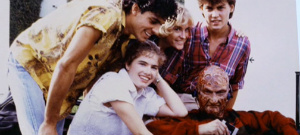

2 Responses to NEVER SLEEP AGAIN – A Nightmare on Elm Street (1984)